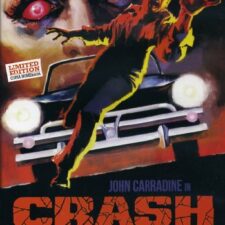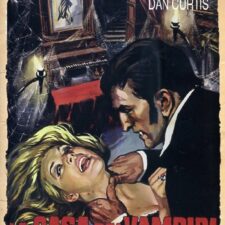Descrizione
Directed by
Jose Mojica Marins
Cast:
Jose Mojica Marins, Sergio Hingst, Ozualdo Candeias, Andreia Bryan, Lurdes Ribas, Mario Lima, Roney Wanderney, Helena Nogueira, Graveto, Jose Carlos
Cinematography
Giorgio Attili
Art Director
Nico Rosso
Film Editor
Luis Elias
Written by
Jose Mojica Marins and Rubens F. Lucchetti
Produced by
Giorgio Attili, Jose Mojica Marins and George Michel Serkeis
Year
1969
Supplements: The Nightmares of Coffin Joe Eurotika documentary and a biography and filmography of Jose Mojica Marins.
Dolby Surround – Region 0 – Portuguese sub. English
The reasons for the perceived moral collapse of modern Brazilian society are being debated on the TV show A Light in the Darkness. A psychiatrist called Doctor Sergio presents a series of dramatic vignettes, which serve to highlight the perils of narcotics abuse and illicit sexual activity. The doctor’s fellow intellectual panelists wonder what filmmaker Jose Mojica Marins is doing on the show and they probe Sergio about the rumours that suggest that the doctor is an unethical operator. Sergio admits that he administered LSD to four willing human subjects and he goes on to reveal the fuller details of his experiment: the four test subjects were asked to focus on a poster depicting Marins’ filmic alter ego Coffin Joe and their subsequent LSD-induced hallucinations transported each of them to a psychedelic Hell-world where they were tormented by a malevolent supernatural entity, the misogynistic and sadistic Coffin Joe in person.
Awakening of the Beast suggests that Jose Mojica Marins was an extremely media-savvy operator. The show is distinctly post-modern in the way that it draws upon a number of filmic textual devices and styles, along with a variety of music and print-based texts, and jumbles them all into a sub-psychedelic and surreal but highly effective exercise in self-promotion. The show opens with Coffin Joe himself, sporting his sinister black top hat, cloak and mysterious medallion and directly addressing the audience with the words, “My world is strange … Though it may be filled with strange people, none … are stranger THAN YOU!” Coffin Joe’s schlock horror approach here brings to mind elements of the mock horror stage personas adopted by Screamin’ Jay Hawkins and his UK counterpart Screaming Lord Sutch. The film’s credits then play over shots of panels from Coffin Joe comics before the action cuts to the dramatic vignettes that Doctor Sergio is relating to his fellow TV show panelists. One panelist describes the doctor’s case-studies as being, “A catalogue of depravity.”
Depraved or not, the vignettes themselves are a bit of a mixed bag in cinematic terms. Some of them are staged in a fairly conventional way, coming on like simple dramatic reconstructions of the doctor’s file papers. Others are set to music and appear to have been staged and performed by a beatnik performance art collective. The choreography that marries the visuals to the soundtrack in these ‘performance art’-like vignettes works very well for the most part and some interesting songs are featured too. Many of the vignettes contain very surreal or bizarre elements: a sequence where a sleazy businessman is eating pasta winds up bringing to mind Auntie Jessie’s nightmare about eating spaghetti from The Beatles’ Magical Mystery Tour film. Nearly all of the vignettes feature sleazy or disturbing scenarios and characters, along with varying degrees of female nudity or females in a state of partial undress. Consequently, there’s a bit of a sub-exploitation/sexploitation cinema-like feel apparent here that clashes with the art film-cum-world cinema-like ambience that is also present. Evidence of budgetary constraints, and the use of the odd (intentionally?) incongruous music cue, gives a couple of the sequences a slightly Ed Wood-ish air.
The scenes set on the A Light in the Darkness TV programme are staged in a convincing round-table-debate-cum-current affairs TV show-like manner, with realistic behind-the-scenes activity in the TV studio being revealed at one point. It’s here that Jose Mojica Marins gets to offer a representation of his real world self, telling the panel, “My position is neutral. I don’t even know why I’m here.” Marins warns the snobbish intellectuals that they should not confuse Marins the man with Coffin Joe: Marins stresses that Coffin Joe is merely a fictional character that he plays. Sergio explains that he saw Marins on another TV show, The People’s Court of Truth, which allows the doctor to reminisce about that show’s content: seen on a television screen, Marins is questioned and judged by a panel of regular Brazilian citizens, who wind up validating his opinions and acknowledging his integrity and talent. This is a neat device that effectively allows Marins to provide evidence of the plaudits that his work has received and to articulate his views on the state of filmmaking in Brazil, etc, directly to his current film’s audience. A sequence which details the doctor setting up his LSD-based experiment features encounters with more Coffin Joe comics, a Coffin Joe poster, a Coffin Joe pop song and a visit to a cinema that is screening a Coffin Joe film, resulting in clips from the earlier film being utilized onscreen here.
All of the action up to now has been presented in black and white but when Doctor Sergio’s test subjects have their doses of LSD administered, their subsequent hallucinations are brought to life via some very lively and really quite startling colour cinematography. Some ultra-psychedelic colour schemes and solarization effects are employed in this section of the film. Coffin Joe’s nightmarish world is inhabited by all manner of strange creatures and these creatures are brought to life in some very inventive and effective ways. The lengthy and surreal hallucinogenic sequence, like some of Doctor Sergio’s earlier dramatic vignettes, features a whole range of disorientating, freak out inducing camera angles and whacked out and trippy editing techniques. The soundtrack here features an avant-garde cacophony that is very unsettling and disturbing. Treated cackles, screams, moans and cries, strange choral arrangements and electronic effects fed through audio generators, reverb units and echo boxes all vie for aural supremacy. It’s all very effective stuff. The doctor reveals that his test subjects survived their ordeal and he imparts one final revelation that is intended to simultaneously counter the accusations of unethical working methods and support his theses concerning Brazilian society’s perceived moral decline.







